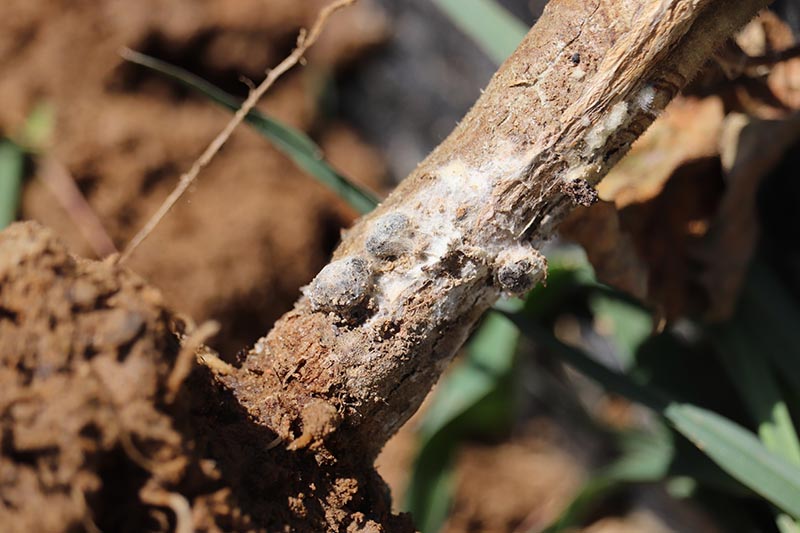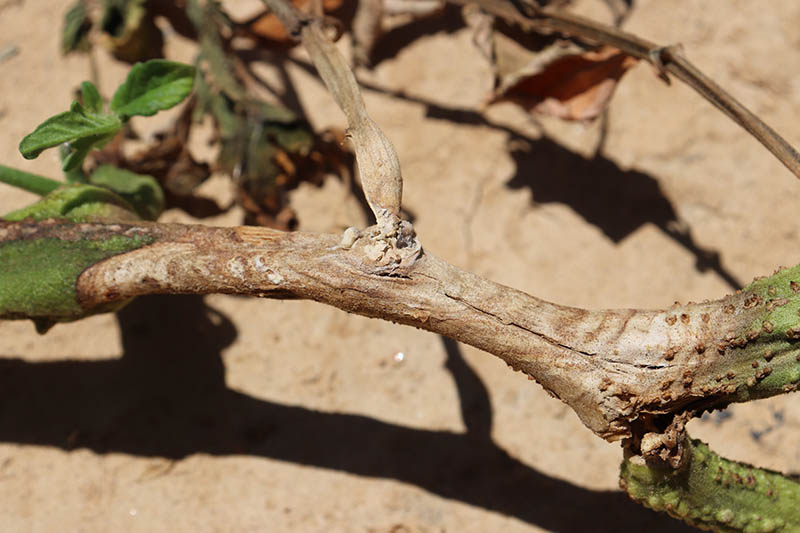This disease, which is also known as timber rot, white mold, or sclerotinia stem rot, can really hurt tomato plants in cold, wet places, and it can stay in the soil for up to 10 years.
And it’s not only your tomatoes that may be at risk. White mold can infect more than 400 species of plants, including such important crops as potatoes and peppers.
Caused by the fungal pathogen Sclerotinia sclerotiorum, this disease is widespread in sub-tropical and temperate areas. Over 60 names have been used to date to refer to diseases caused by this pathogen.
Weeds can also get infected with it, which is not a surprise since they can keep the pathogen alive.
Lamb’s-quarter, pigweed, Canada thistle, wild mustard, hairy nightshade, and ragweed are just a few of the well-known weeds that host weeds.
White spots on tomato stems can be alarming for gardeners. After all, you’ve spent time and effort caring for your plants – you don’t want them ravaged by disease. However, while diseases are one potential cause of white spots on tomato stems, there are other causes as well. Read on to learn what might be behind those white spots, and what you can do about them.
Potential Causes of White Spots on Tomato Stems
There are a few potential culprits that can lead to white spots on tomato plant stems:
- Powdery mildew
- Hard water deposits
- Adventitious roots
- Pest damage
- Sunscald
Let’s explore each of these in more detail
Powdery Mildew
Powdery mildew is a fungal disease that affects many plants, including tomatoes. It thrives in humid conditions with temperatures between 60-80°F.
Powdery mildew causes white spots that look like powder sprinkled on the leaves and stems of plants. These white spots start out small but can eventually cover entire leaves and stems. The leaves may curl up or become distorted by the fungal growth.
On tomatoes, powdery mildew typically starts on older growth. It spreads to new growth if uncontrolled. Lower leaves often defoliate once infected.
Fortunately, powdery mildew usually doesn’t kill tomato plants outright. But it can weaken them by reducing photosynthesis. This makes the plant more prone to other issues like sunscald or pest damage.
Hard Water Deposits
If you water your tomato plants with hard water, you may notice white spots or residue left behind when the water evaporates. These spots are mineral deposits from the hard water.
Calcium, magnesium, and other dissolved minerals in hard water get left behind when the water evaporates These minerals won’t directly harm your tomato plants But they can block sunlight from reaching leaf surfaces, potentially reducing photosynthesis.
Adventitious Roots
Tomato stems sometimes form small white bumps called adventitious roots. These “roots” emerge from above-ground portions of the stem. They usually form in response to some kind of stress, like:
- Root damage
- Fluctuating soil moisture
- High humidity
- Herbicide exposure
In most cases, adventitious roots are harmless. They don’t directly damage the plant. However, their presence suggests the plant is stressed.
Adventitious roots can be distinguished from powdery mildew by their bumpy, rounded shape. They do not rub off like powdery fungal growth. Gently scratching the spots with your fingernail should help determine if they are roots or mildew.
Pest Damage
Tomato pests like aphids, spider mites, and thrips can all cause stippling, spots, or speckling on tomato plant leaves and stems. The damage may appear white at first, then turn yellow, brown, or black as it spreads.
Carefully inspect the undersides of leaves and along stems to check for active pests. Knock pests off with a strong spray of water. Or wipe them away with a damp cloth if infestations are light. Monitor for signs of reinfestation, since pests reproduce rapidly.
Sunscald
If tomato plants are exposed suddenly to more intense, direct sunlight than they’re accustomed to, sunscald can occur. Theexposed areas of stems and fruit develop bleached-looking spots that eventually turn brown.
Sunscald often happens when pruning overzealously. Removing too much foliage allows harsh sunlight to hit tender stems and developing fruit. Strategic, moderate pruning prevents this.
Young transplants getting acclimated to outdoor sun may also develop minor sunscald. Gentle hardening off over 7-10 days reduces transplant shock.
How to Treat White Spots on Tomato Stems
Now that you know what causes white spots on tomato stems, let’s discuss treatments.
Powdery Mildew Treatments
To treat powdery mildew, first prune back any heavily affected growth. This helps limit spore production.
Improving air circulation also inhibits powdery mildew. Trellising, staking, and moderate pruning all open up the plant canopy.
Finally, use fungicidal sprays as a last line of defense against powdery mildew. Organic options include neem oil, potassium bicarbonate, or Bacillus subtilis. Chemical fungicides with active ingredients like myclobutanil, trifloxystrobin, or chlorothalonil work too.
Rotate between treatment types to prevent resistance. Follow label instructions closely. Start applications at the first sign of mildew to prevent major outbreaks.
Hard Water Deposit Prevention
To prevent hard water deposits, consider collecting rainwater for irrigation. Or use distilled, filtered, or reverse osmosis treated water if possible. These will contain fewer minerals that leave deposits behind.
If using hard water is unavoidable, try to focus water at the soil level. Watering the leaves and stems directly contributes to mineral buildup. Drip irrigation or soaker hoses are ideal for hard water areas.
Adventitious Root Treatments
Adventitious roots don’t require treatment in most cases. But their presence warrants investigation into what stressed the plant.
Check soil moisture and drainage. Ensure plants receive consistent water, butavoid overwatering. Improve drainage with raised beds if soil remains soggy.
Rule out transplant shock, root damage from cultivation, and herbicide exposure too. Address any issues to reduce plant stress.
Pest Prevention and Control
Prevent pests with row covers,trap crops, companion planting, and proper crop rotation. Remove weeds where pests may breed.
Monitor closely and control pests with insecticidal soaps, horticultural oils, neem oil, pyrethrin, or Azera. Target nymphs and eggs before populations explode.
Attract beneficials like ladybugs, lacewings, and syrphid flies with companion plants. They help control pests naturally.
Avoiding Sunscald
Prevent sunscald by acclimating transplants before planting out. Harden off gradually over 7-10 days.
Use protective row covers if transplanting during times of intense sunlight. Remove covers after a week once plants adjust.
When pruning, avoid over-thinning foliage. This exposes tender tissue to sunburn. strategically remove just enough growth to improve air circulation and light penetration.
White spots on tomato stems can result from several causes. Accurate diagnosis guides the proper treatments. Simple fixes like improving air flow, water quality, and plant care often resolve issues. For stubborn problems like powdery mildew, targeted fungicides help protect tomato crops. Pay close attention to plant health and catch problems early before they escalate. With quick action, your tomato plants can thrive despite the occasional white spots on their stems.
Sclerotinia Stem Rot Symptoms
The organism’s scientific name comes from the sclerotia that it makes. This is a classic sign of the disease. These survival structures look like rat droppings – small, black, hard, cylindrical objects.

The sclerotia form in or on dead plant tissue. You can find them inside tomato tissue that has turned white and dry due to the disease. This symptom in tomatoes gives the disease its alternate name, timber rot.
This pathogen first shows up at the base of the main stem, where it meets the ground, or on lower branches. At first, the disease manifests as watery soft rots and bleached areas on the leaf axils and stems.
Next, a white fuzzy mold grows both inside and outside the plant. It then spreads to the flowers, petioles, leaves, and stems. The fruit can also be infected, turn gray, and rot.
As the disease progresses, the plant will wilt. The tissues get even more white and broken, and the black sclerotia appear in seven to ten days. If you cut the sclerotia open, their insides are pinkish-white.
How Your Garden Can Become Infested with Timber Rot
Most of the time, timber rot is spread by spores that fly through the air from infected plants or crops and land on your plants.

If successful, the fungus will then produce sclerotia, which can spread the disease further in your garden.
The wind can also blow soil or crop debris infested with sclerotia into your garden.
Water can spread spores or sclerotia, and irrigation water is a common source of infection in commercial fields.
Prevent & Treat Powdery Mildew and 4 Home Remedies that Work!!
FAQ
What is the white mold on my tomato stems?
Is it safe to eat tomatoes with white spots?
Is it safe to eat a tomato with mold on the stem?
What does stem rot look like on tomatoes?
- A Complete Guide to Caring for Yuki Cherry Blossom Shrub - January 23, 2025
- Identifying Red Hot Poker Seeds: What to Look For When Harvesting Torch Lily Pods - January 23, 2025
- A Complete Guide to Harvesting Evening Primrose Seeds - January 23, 2025
